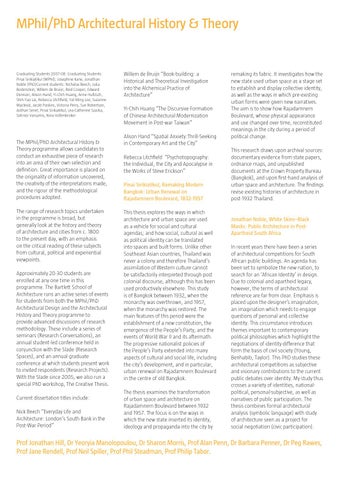MPhil/PhD Architectural History & Theory
Graduating Students 2007-08: Graduating Students: Pinai Sirikiatikul (MPhil); Josephine Kane, Jonathan Noble (PhD)Current students: Nicholas Beech, Julia Bodenstein, Willem de Bruijn, Reid Cooper, Edward Denison, Alison Hand, Yi-Chih Huang, Anne Hultzsch, Shih-Yao Lai, Rebecca Litchfield, Yat Ming Loo, Suzanne Macleod, Jacob Paskins, Victoria Perry, Sue Robertson, Aslihan Senel, Pinai Sirikiatikul, Lea-Catherine Szacka, Sotirios Varsamis, Nina Vollenbroker
The MPhil/PhD Architectural History & Theory programme allows candidates to conduct an exhaustive piece of research into an area of their own selection and definition. Great importance is placed on the originality of information uncovered, the creativity of the interpretations made, and the rigour of the methodological procedures adopted. The range of research topics undertaken in the programme is broad, but generally look at the history and theory of architecture and cities from c. 1800 to the present day, with an emphasis on the critical reading of these subjects from cultural, political and experiential viewpoints. Approximately 20-30 students are enrolled at any one time in this programme. The Bartlett School of Architecture runs an active series of events for students from both the MPhil/PhD Architectural Design and the Architectural History and Theory programme to provide advanced discussions of research methodology. These include a series of seminars (Research Conversations), an annual student-led conference held in conjunction with the Slade (Research Spaces), and an annual graduate conference at which students present work to invited respondents (Research Projects). With the Slade since 2005, we also run a special PhD workshop, The Creative Thesis. Current dissertation titles include: Nick Beech “Everyday Life and Architecture: London’s South Bank in the Post-War Period”
Willem de Bruijn “Book-building: a Historical and Theoretical Investigation into the Alchemical Practice of Architecture” Yi-Chih Huang “The Discursive Formation of Chinese Architectural Modernization Movement in Post-war Taiwan” Alison Hand “Spatial Anxiety:Thrill-Seeking in Contemporary Art and the City” Rebecca Litchfield “Psychotopography: the Individual, the City and Apocalypse in the Works of Steve Erickson” Pinai Sirikiatikul, Remaking Modern Bangkok: Urban Renewal on Rajadamnern Boulevard, 1832-1957 This thesis explores the ways in which architecture and urban space are used as a vehicle for social and cultural agendas; and how social, cultural as well as political identity can be translated into spaces and built forms. Unlike other Southeast Asian countries, Thailand was never a colony and therefore Thailand’s assimilation of Western culture cannot be satisfactorily interpreted through post colonial discourse, although this has been used productively elsewhere. This study is of Bangkok between 1932, when the monarchy was overthrown, and 1957, when the monarchy was restored. The main features of this period were the establishment of a new constitution, the emergence of the People’s Party, and the events of World War II and its aftermath. The progressive nationalist policies of the People’s Party extended into many aspects of cultural and social life, including the city’s development, and in particular, urban renewal on Rajadamnern Boulevard in the centre of old Bangkok. The thesis examines the transformation of urban space and architecture on Rajadamnern Boulevard between 1932 and 1957. The focus is on the ways in which the new state inserted its identity, ideology and propaganda into the city by
remaking its fabric. It investigates how the new state used urban space as a stage set to establish and display collective identity, as well as the ways in which pre-existing urban forms were given new narratives. The aim is to show how Rajadamnern Boulevard, whose physical appearance and use changed over time, reconstituted meanings in the city during a period of political change. This research draws upon archival sources: documentary evidence from state papers, ordnance maps, and unpublished documents at the Crown Property Bureau (Bangkok), and upon first-hand analysis of urban space and architecture. The findings revise existing histories of architecture in post-1932 Thailand. Jonathan Noble, White Skins–Black Masks: Public Architecture in PostApartheid South Africa In recent years there have been a series of architectural competitions for South African public buildings. An agenda has been set to symbolize the new nation, to search for an ‘African Identity’ in design. Due to colonial and apartheid legacy, however, the terms of architectural reference are far from clear. Emphasis is placed upon the designer’s imagination, an imagination which needs to engage questions of personal and collective identity. This circumstance introduces themes important to contemporary political philosophies which highlight the negotiations of identity-difference that form the basis of civil society (Young, Benhabib, Taylor). This PhD studies these architectural competitions as subjective and visionary contributions to the current public debates over identity. My study thus crosses a variety of identities, nationalpolitical, personal-subjective, as well as narratives of public participation. The thesis combines formal architectural analysis (symbolic language) with study of architecture seen as a project for social negotiation (civic participation).
Prof Jonathan Hill, Dr Yeoryia Manolopoulou, Dr Sharon Morris, Prof Alan Penn, Dr Barbara Penner, Dr Peg Rawes, Prof Jane Rendell, Prof Neil Spiller, Prof Phil Steadman, Prof Philip Tabor.
Show Cat 08.indd 190
12/6/08 17:49:50
